|
|
| |
The Manica in the Roman Army up
to 150 AD Caballo
(Paul Brown) 2007 
|
| |
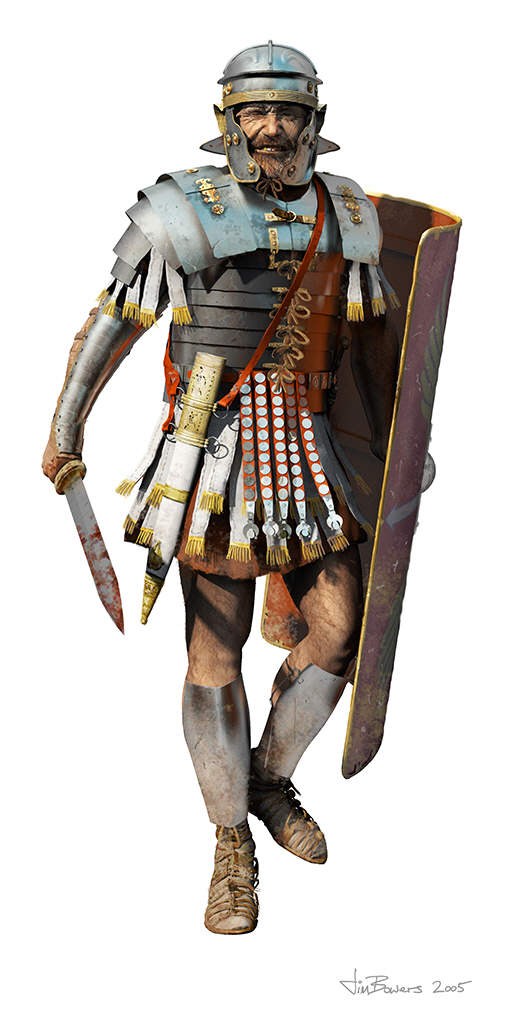
Roman legionary , Dacian Wars- with kind permission
from Jim Bowers
|
| |
1. Introduction
Recently, the Carlisle finds have led to old conclusions
about the manica being re-visited (e.g. “It was only used against
the Dacian falx-men”) and old finds being re-evaluated (the
Newstead finds). Manicae have been seen reconstructed by a number
of re-enactment groups- most notably in the Ermine Street Guard.
This article aims to pull together the many excellent
articles and book chapters on the manica in early Imperial Roman
times (0-150 AD) , and to give amateur historians and re-enactors
alike an easily referenced article on the manica - what it is, when
it was used, and some thoughts about how it could be re-constructed.
I would particularly like to thank for help, advice,
and permission to use photographs, drawings, and conclusions Dr.
Mike Bishop, Dan and Susanna Shadrake, Adrian Wink, and Jim Bowers.
Any errors and minor to catastrophic failures of judgement and knowledge
are entirely down to me!
I will aim to give a short history of the manica,
look at the Roman evidence - written, sculptural, mosaic, and (most
importantly) actual finds. I will then go on to describe possible
re-constructions, experiences of modern users, and then draw some
conclusions.
What is a manica?
I will define a manica is a segmented arm protector
made of iron or cupric alloy- leaving the textile and leather arm
protectors to other , more knowledgable individuals.
2. History
The manica has a long history, with Xenophon
describing cavalry of 4th/5th century BC equipped with an articulated
armguard, a ‘Cheira’ on the left arm in place of a shield.
In Pergamon, pieces of an iron armguard were
found, and armguards are also depicted in the sculpture at the Temple
of Athena at Pergamon.
At Ai Knaum, another segmented armguard was found
in the Hellenistic arsenal dated to 150 BC. This had a large upper
plate and about 35 over-lapping curved plates, which appear to “under-lap”
downwards from the hand/wrist plates- that is, with each plate being
under the next as it goes up the arm. This would protect and deflect
a sword or spear thrust. The opposite way (plates over-lapping downwards)
would deflect the enemy’s spear point into the gap between
the plates towards the unprotected arm – which, on balance,
is probably not a good idea
3. Roman evidence
a. 0-50 AD Gladiators.
Gladiators demonstrate a wide variety
of armguards- in metal, leather, and padding.
|
| |
|
| |
However, a key development came
with the crupellarius- a heavily armed gladiator of Gaulish origin.
Tacitus describes their use is fighting against legionaries in the
revolt of Florus and Sacrovir of AD21:-
"There was also a party of slaves training
to be gladiators. Completely encased in iron in the national fashion,
these crupellarii, as they were called, were too clumsy for offensive
purposes but impregnable in defence…the infantry made a frontal
attack. The Gallic flanks were driven in. The iron-clad contingent
caused some delay as their casing resisted javelins and swords.
However, the Romans used axes and mattocks and struck at their plating
and its wearers like men demolishing a wall. Others knocked down
the immobile gladiators with poles and pitchforks , and, lacking
the power to rise, they were left for dead." Tacitus, Annales,
III 43
As it happens, a bronze figure was found at
Versigny, France that matches this description, and is reproduced
below (with kind permission on Mike Bishop and Susanna Shadrake)
|
| |
|
| |
As can be seen, this
segmentation covered both arms, body, and legs.
A rather wonderful re-enactment of this Ned Kelly of the Roman world
has been made by Familia Gladiatoria of Hungary- and it is a sight
that must have impressed watching soldiers.
|
| |
 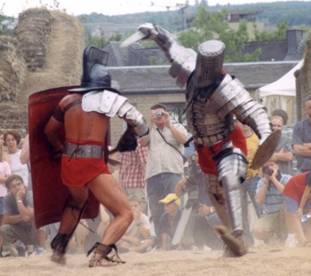 Crupellarius reconstruction - with permission
of Familia Gladiatoria of Hungary
Crupellarius reconstruction - with permission
of Familia Gladiatoria of Hungary |
| |
Further evidence- this time placing
the metal manica firmly in the Roman army, comes from the tombstones
of Sextus Valerus Severus and Gaius Annius Salutus, both from Mainz
and legionaries of Legio XXII Primigenia, who were based in Mainz
between AD 43-70. Their tombstones show manicae as part of the decorative
border of weaponry surrounding the text of the tombstone. Severus'
manica shows eleven plates and a hand shaped section of four plates
(though it would be unwise to rely on this sculptural reference as
opposed to the archaeological finds). However, this clearly places
the manica as being used- although rarely- by Roman legions on the
Rhine around AD 43-70.
b. Roman Exidence 50-150 AD
Sculptural evidence
The most useful source is the Tropaeum Traiani metopes
at Adamklissi, constructed c. 107/8 and depicting Trajan’s
Dacian wars. Although the same campaign as shown on Trajan’s
Column, the equipment shown is very different. As a monument set
up closer to the front line and the actual soldiers - and less of
a “Head Office” official propaganda monument like Trajan’s
Column- Adamklissi is generally regarded as being more accurate
in its depiction of the troops.
Of the metopes showing troops in battle, virtually
all show legionaries wearing manicae on their sword or spear arm.
Those that do not show:-
-Auxilaries (metope XIV)
-Cavalry (metope 1)
One legionary, dressed in mail with a scutum (metope
XXIX) does not appear to wear a manica, though the stone is damaged.
Some others have suffered similar or worse damage, and it is not
possible to conclusively prove that manicae are depicted in these
pieces..
Troops marching or off-duty, standard bearers, cornicens,
attending senior officers, or holding captives do not wear manicae.
Legionaries are shown in mail or scale, but
not in lorica segmentata as on Trajan’s Column. Helmets with
cross-bracing and greaves are also depicted. Auxilaries are shown
in mail, with senior officers in lorica musculata
|
| |
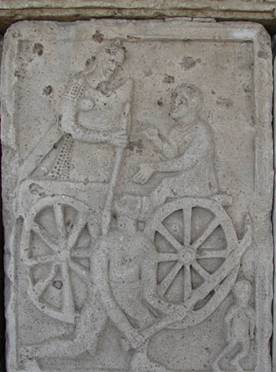 Legionary with mail, manica and spear with Dacian
falxman
Legionary with mail, manica and spear with Dacian
falxman |
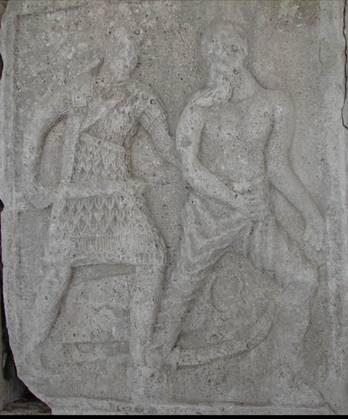 Legionary in scale, holding sword and Dacian
falxman
Legionary in scale, holding sword and Dacian
falxman |
| |
 Legionary in mail, manica with sword and Dacian
falxman
Legionary in mail, manica with sword and Dacian
falxman |
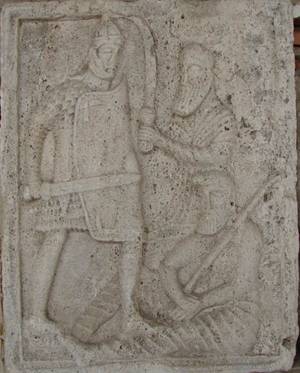 Legionary in scale, manica with sword and two
Dacian falxmen
Legionary in scale, manica with sword and two
Dacian falxmen |
| |
(All pictures reproduced with kind permission
of Jack O'Keefe and Legio XX of Ireland.)
|
| |
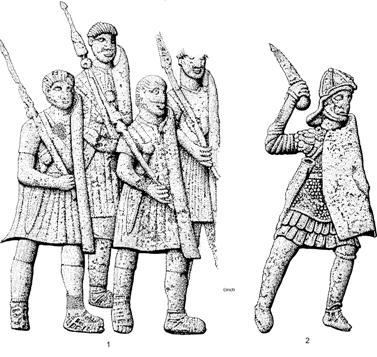 Marching "offduty" soldiers, compared
with soldier in combat
Marching "offduty" soldiers, compared
with soldier in combat
(With kind permission from Mike Bishop)
|
| |
It is understandable that the theory
grew up that the manica was brought in to combat the fearsome Dacian
falx, whose wielders were later to guard the Emperor himself (see
column of Marcus Aurelius and coinage). However, archaeological finds
elsewhere invalidate this theory.
Archaeological evidence
A number of finds have been made- or subsequently
recognised as manicae. The first was from the Waffenmagazin at Carnuntum,
followed by the copper alloy curved plates from Newstead, which
also provided pieces belonging to an iron manica. Both came from
the well in the headquarters building that also conserved the Newstead
lorica segmentata. These were (incorrectly) described by Robinson
as thigh guards, and the finds are probably not complete, with more
plates/ lames being in the original.
|
| |
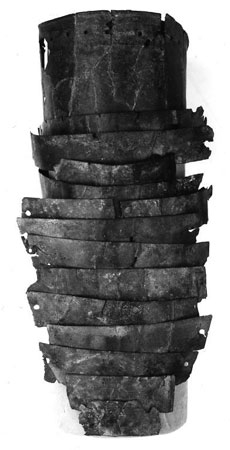 Newstead Manica (copper alloy) , National Museums
of Scotland
Newstead Manica (copper alloy) , National Museums
of Scotland |
| |
Further plates have
now been identified from Richborough, Corbridge, Eining, Leon, and
possibly complete manicae have been found at Carlisle and at Ulpia
Traiana Sarmizegetusa in Dacia/ Romania .
The finds of manicae therefore stretch across the
Roman Empires- and cannot be simply a defence against falx-men.
The Carlisle finds, from a Hadrianic context
are the most important (though I have been unable to obtain photographs
and details of the Romanian find). It appears to be one complete
iron manica. In addition, two halves of two other iron manicae were
found. I understand that two further manicae were found, but these
are yet to be examined and published.
|
| |
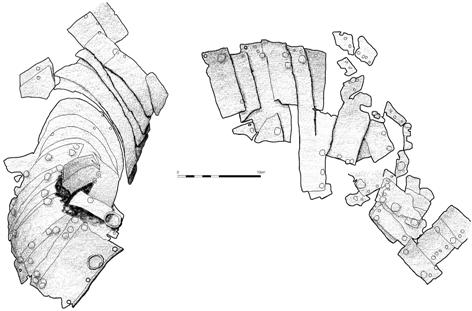 Carlisle Manica (with kind permission from Mike
Bishop)
Carlisle Manica (with kind permission from Mike
Bishop) |
|
|
X rays of the manica when found also show
convincingly that the manica plates under-lapped from the wrist- to
provide better defence against a thrust.
One has surviving copper-alloy ring fittings- another a hook similar
to lorica segmentata fastenings.
|
| Right. A legionary infantryman from
the Adamklissi Monument, showing a "manica lamminata"
with body defences of 'pteruges' and a corset of scale. |
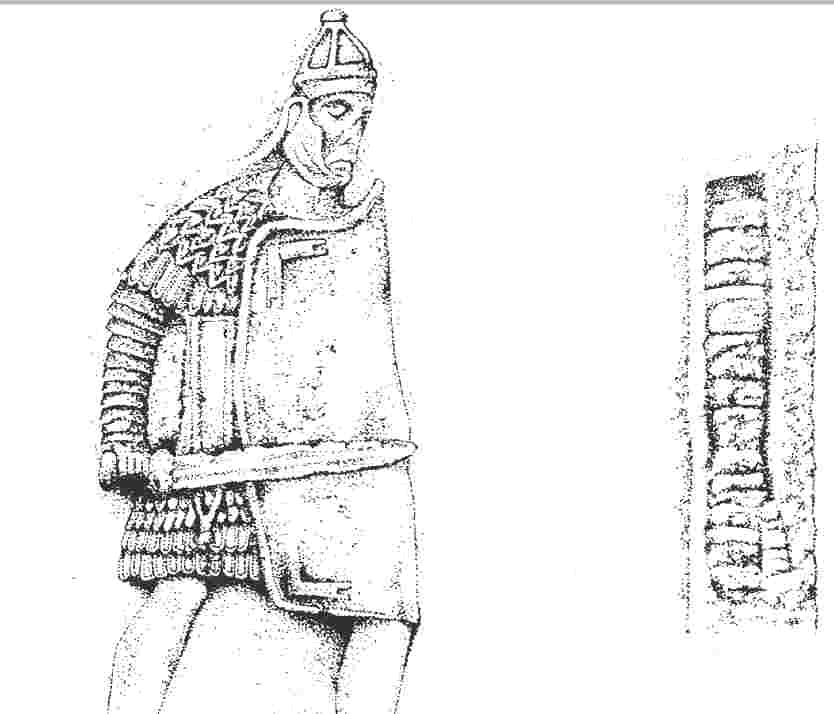 |
Left. The crude representation of a
"manica laminata" from the border of the grave stele of
the legionay infantryman Sextus Varus Severus. The arm guard appears
to show complete coverage of the fingers and thumb of its owner. |
| |
|
| |
c. Roman Evidence Post 150 AD
After 150 AD (though not the main aim of this article), further
evidence exists for Gladiator manicae, with both mosaics and references
to ‘Manicarii’ at the gladiator training schools during
the reign of Commodus.
The 2nd/ 3rd century relief at Alba Julia shows a legionary wearing
a segmentata (of unique design) and a manica
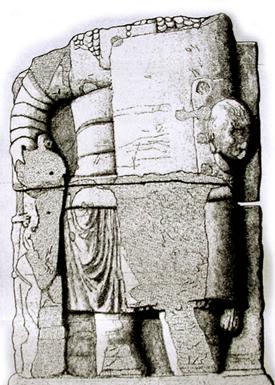
Alba
Julia relief (by kind permission of Mike Bishop)
In Dura Europos, the famous “clibanarii” graffito appears
to depict manicae, which are also shown in medieval copies of the
(much) later ‘Notitia Dignitum’.
Finally, Ammianus describes Roman cavalry on parade in 350 AD as
“Laminarum circuli tenues apti corporis flexibus ambiebant
per omnia membra diducti.” (Thin circles of iron plates,
fitted to the curves of their bodies, completely covered their limbs).
4. Re-creating the manica
Based on the work of Mike Bishop, the armguards had about 35 iron/
steel or copper alloy plates below the main upper plate, articulated
on internal leathers fastened by copper-alloy rivets. The upper
plate (based on Newstead) is 25.8 cm long and 9 cm wide, with a
turned upper edge and holes for the attachment of a lining and straps,
tapering down to the smallest plate of 12cm long. The lower plates
were 2.7 cm wide.
Comparing with the Carlisle manica, the main plates varied between
25 and 30 mm wide, again shortening as they progressed down the
arm.
At the wrist, the Eining and Leon examples were riveted together
and not articulated.
Some kind of padding also existed, and Van Groller noted remains
of linen and leather. The Newstead manica also had fragments of
leather surviving when it was first found.
Susanna Shadrake and Britannia have also noted the tendency of
the manica to rotate around the arm in combat- also noted by some
other groups who have used these in combat. This can be counter-balanced
by a disc being worn around the pectoral area- as seen in the mosaic
below (also on the cover of her highly recommended book "The
World of the Gladiator".) No unequivocal evidence has so far
been found of such discs in a military context, but some such device
seems likely.
|
| |
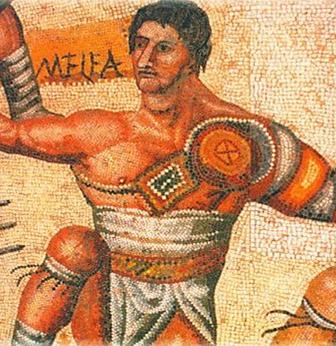 4th Century Villa Borghese mosaic, reproduced
with kind permission of Susanna Shadrake
4th Century Villa Borghese mosaic, reproduced
with kind permission of Susanna Shadrake |
| |
Britannia's reconstructions show
that an unsecured metal manica needs a strap, like a baldric, passing
under the shield arm, if it is not to slip down under its own weight.
A padded manica made of fabric, in contrast, stays up held by the
thonging that ties it to the arm.
Finally, the manica is primarily worn on the
upside of the arm, and not over the elbow. This is because this
would be the most exposed part of the arm when using a sword . This
is supported by the design as a manica going over the elbow would
need a couter plate to allow the manica to expand over the joint.
No such plate has been found.
|
| |
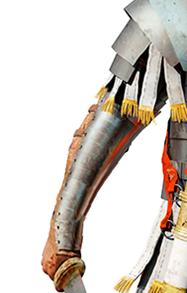 "Correct" method of manica position:
Picture by kind permission of Jim Bowers
"Correct" method of manica position:
Picture by kind permission of Jim Bowers |
| |
This seems to contradict some sculptural
representations- but is supported by the actual finds. Of course,
the longer the plate, the more it could encircle the arm and give
more protection.
Overall, in reconstructing the manica, the following
components are likely
-Shoulder plate - 1
-Lames - c. 35
-Leathering copper-alloy rivets -90-120
-Internal leathers - 3-4
-Padded fabric and leather lining - 1
|
|
|
|
|
|
Replica manica based on the Carlisle finds,
reproduced with kind permission of Susanna Shadrake and
Michael Hardy
|
|
|
Manica on the Column of Arcadius (AD 402)
This corroborates the Notitia Dignitam in confirming manica
use in the late fourth / early fifth century.
|
5. Conclusion
In conclusion, the manica- having had a long history
before- came into the Roman army between AD 21 and 70, with widespread
use throughout the Empire. At the moment, only legionary use is
attested but of course “absence of evidence is not evidence
of absence”. It appears to be a combat item of equipment, and
not used day to day.
“Official sculpture” does not depict the
manica, which is only shown in sculpture from the “front line”
in Dacia and the Rhine. It is only possible to speculate why this
might be, but it might be thought that a gladiator-associated item
of kit should not be shown on a soldier and citizen of Rome? Gladiators,
despite their “footballer celebrity” status, were also
regarded as somewhat degraded- “solemnly handed over body and
soul to our masters” (Petronius, Satyricon 117) and Augustus
prohibiting young men of rank from becoming gladiators.
Finally, it is completely justified for re-enactment
groups depicting first century Rome to have members wearing a manica
if a potential combat situation is to be shown.
Key Bibliography
Lorica Segmentata, Volume 1- M.C. Bishop
The Armour of Imperial Rome- H.R.R Robinson
The World of the Gladiator- Susanna Shadrake
A Roman Frontier Post and its People- James Curle
Various members of the society have adopted
different means of attaching their manica.
To read articles relating to this click
here. Note the file is 1.6MB
|
|

